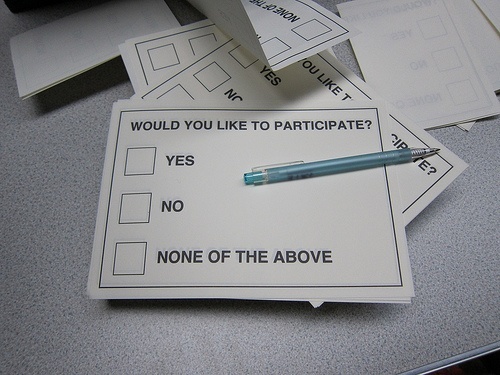
Just like smaller parties, independent voices within the major parties struggle with difficulty of signature campaigns for election candidacy. Independents struggle to meet signature requirements across the country. Ballot Access News, written by San Francisco based election reformer Richard Winger, had an interesting analysis to go with the recent article from the New York Times. In the post, New York Times Story on Difficulty of Getting Signatures for Republican Party Primary Petitions, Winger adds his view on the story:
 The New York Times story explains the difficulty of collecting signatures for Republican primary candidates in New York city. With only 470,000 registered Republicans in the city, even mainstream Republicans have difficulty collecting 3,750 valid signatures of party members. As the story says, normal petitioning on the street barely works, and petitioners find they must first get a list of registered Republicans and then try to find them at home. This is why the new legislation in Arizona, HB 3605, is so devastating to Arizona’s minor parties. The bill requires over 5,500 signatures of party members (or registered independents) and the Green Party only has about 6,000 registered members in the state.
The New York Times story explains the difficulty of collecting signatures for Republican primary candidates in New York city. With only 470,000 registered Republicans in the city, even mainstream Republicans have difficulty collecting 3,750 valid signatures of party members. As the story says, normal petitioning on the street barely works, and petitioners find they must first get a list of registered Republicans and then try to find them at home. This is why the new legislation in Arizona, HB 3605, is so devastating to Arizona’s minor parties. The bill requires over 5,500 signatures of party members (or registered independents) and the Green Party only has about 6,000 registered members in the state.
Winger also add that both New York state and NYC have a residency requirement for collecting signatures and “only New York residents can circulate petitions.” Also, take a look at this excerpt from the New York Times article as well:
Every mayoral candidate needs 3,750 voter signatures to appear on the primary ballot in September. With about 3 million registered Democrats in the city, Democratic canvassers can stand on a street corner and let the deluge pour forth. It is not so easy for Republicans, whose party counts only about 470,000 registered voters, mostly in enclaves outside Manhattan. Republican hopefuls like Mr. Catsimatidis can be so hard-pressed for signatures that they make individual appointments with registered voters.
“You can’t stand outside the supermarket, you can’t stand outside the subway stop, you can’t collect signatures on the street,” said Eric Ulrich, a Republican city councilman from Queens, who said he has had his grandmother, among other volunteers, gather signatures for him. “You literally have to go knocking on doors, door to door, to gain ballot access.”
Arizona’s current laws are being hotly debated, as discussed in Mary Jo Pitzl’s article in AZJournal “Green Party wins ballot status“:
To gain ballot access, a new political party must gather signatures on a county by county basis, achieving over 20,000 good signatures from registered voters. Once this has been achieved the party must run a candidate for Governor or President who garners at least 5% of the vote to maintain ballot access for an additional two years, maintain at least 1% of registered voters registered with their party, or gather approximately the same number of signatures again every two years. The Democratic, Libertarian, and Republican parties have ballot access by voter registrations. In 2008, the Arizona Green Party gathered enough signatures to gain ballot access.
Some information from the New York State Board of Elections:
Persons wishing to run for elective office may be nominated either by a political party or through the filing of an independent nominating petition. Party members may also circulate petitions to create the opportunity to write in the name of an unspecified person for an office in which there is no contest for the party endorsement. The current political parties are the Democratic, Republican, Conservative, Working Families, Independence and Green parties. Any person who is not nominated by one of these parties must file an independent nominating petition. The requirements for all petitions are contained in Article 6 of the Election Law ( 3,303KB). The provisions for village elections vary slightly, and the reader is directed to Article 15 of the Election Law ( 3,303KB) for specifics.
Leave a Reply